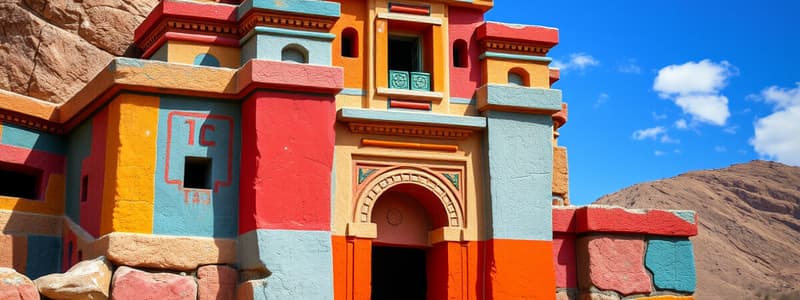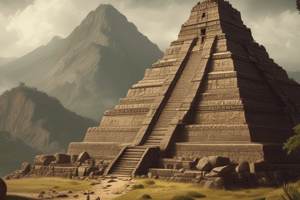Podcast
Questions and Answers
What is a characteristic feature of Inka architecture as described?
What is a characteristic feature of Inka architecture as described?
- Use of metallic structures
- Granite stone masonry (correct)
- Application of mortar between stones
- Inclusion of wood in construction
Why is building on the Andean mountains challenging?
Why is building on the Andean mountains challenging?
- Owing to the diverse ecosystems and terrains (correct)
- The lack of natural resources
- Due to the high altitude and thin air
- Because of extreme weather patterns
What kind of trade developed early in Andean history due to environmental challenges?
What kind of trade developed early in Andean history due to environmental challenges?
- Short and long-distance trade (correct)
- Luxury goods trade
- Import trade
- Barter trade only
What construction technique was notably used at Machu Picchu?
What construction technique was notably used at Machu Picchu?
What did the Inka employ to shape their stones for construction?
What did the Inka employ to shape their stones for construction?
What type of stone is primarily associated with Inka architecture?
What type of stone is primarily associated with Inka architecture?
What distinguishes the stones used in Inka construction from those in other cultures?
What distinguishes the stones used in Inka construction from those in other cultures?
Which of the following structures is not typically associated with Inka architecture?
Which of the following structures is not typically associated with Inka architecture?
What architectural material was considered sacred in the Andes?
What architectural material was considered sacred in the Andes?
Which civilization is noted for its distinctive lithic architecture that met imperial desires?
Which civilization is noted for its distinctive lithic architecture that met imperial desires?
How did the architecture of Tiwanaku influence other civilizations?
How did the architecture of Tiwanaku influence other civilizations?
What function did the stone architecture at Chavín de Huántar serve?
What function did the stone architecture at Chavín de Huántar serve?
What is still not well understood in the study of Inka architecture?
What is still not well understood in the study of Inka architecture?
What was the primary role of Inka architecture in their empire?
What was the primary role of Inka architecture in their empire?
What aspect of Andean architecture remains a relatively young field of study?
What aspect of Andean architecture remains a relatively young field of study?
What challenge is faced in understanding the Inka architecture?
What challenge is faced in understanding the Inka architecture?
What was the primary role of architecture in the early days of the Inka expansion?
What was the primary role of architecture in the early days of the Inka expansion?
What type of architecture was developed by the Inka for military purposes?
What type of architecture was developed by the Inka for military purposes?
How did the Inka manage to expand their territory so rapidly?
How did the Inka manage to expand their territory so rapidly?
What was a critical aspect of the design of the Inka's military tent cities?
What was a critical aspect of the design of the Inka's military tent cities?
What materials played a significant role in the Inka Empire's military architecture?
What materials played a significant role in the Inka Empire's military architecture?
What did the Inka's ephemeral architecture signify in their society?
What did the Inka's ephemeral architecture signify in their society?
What challenge is noted regarding the knowledge of Inka architecture?
What challenge is noted regarding the knowledge of Inka architecture?
What geographical challenges did the Inka face in deploying their military architecture?
What geographical challenges did the Inka face in deploying their military architecture?
What is a key characteristic of polygonal blocks compared to ashlar blocks?
What is a key characteristic of polygonal blocks compared to ashlar blocks?
Why are the corners of ashlar blocks particularly significant during carving?
Why are the corners of ashlar blocks particularly significant during carving?
What factor contributes to tourists' fascination with polygonal blocks?
What factor contributes to tourists' fascination with polygonal blocks?
How does the carving process of polygonal and ashlar blocks differ in terms of flexibility?
How does the carving process of polygonal and ashlar blocks differ in terms of flexibility?
What does the ease of making polygonal blocks imply about the skill level required?
What does the ease of making polygonal blocks imply about the skill level required?
What does the process of working stone signify for the Inka?
What does the process of working stone signify for the Inka?
What architectural aspect distinguishes ashlar blocks from polygonal blocks?
What architectural aspect distinguishes ashlar blocks from polygonal blocks?
What happens if a mason makes a mistake when carving an ashlar block?
What happens if a mason makes a mistake when carving an ashlar block?
What is a marca uasi primarily used for?
What is a marca uasi primarily used for?
What does the term 'pata' refer to in Inka architecture?
What does the term 'pata' refer to in Inka architecture?
What misunderstanding did the Spanish have regarding Inka spatial terminology?
What misunderstanding did the Spanish have regarding Inka spatial terminology?
Inka raised platforms used for activities are referred to as what?
Inka raised platforms used for activities are referred to as what?
How do modern outsiders often misinterpret Inka spaces?
How do modern outsiders often misinterpret Inka spaces?
What does the term 'pampa' suggest about a space?
What does the term 'pampa' suggest about a space?
Which of the following was a significant site named by the Inka?
Which of the following was a significant site named by the Inka?
What is an usnu in Inka architecture?
What is an usnu in Inka architecture?
Flashcards are hidden until you start studying
Study Notes
Inka Architecture and Ecosystems
- Inka architecture is closely associated with the rugged Andean mountains, the longest and second highest mountain range globally.
- The Andes host diverse ecosystems, ranging from the driest desert to lush jungles, along with glaciers, barren plains, and dense forests.
- Construction in such varied landscapes has resulted in early development of trade networks and distinct architectural traditions.
Characteristics of Inka Stone Masonry
- Inka architecture is renowned for its stone masonry, notably exemplified by Machu Picchu, which primarily utilizes granite.
- Inka masons crafted granite blocks to fit precisely together without mortar, employing careful shaping techniques.
- Stone blocks come in two types: polygonal blocks, with many angles laid irregularly, and ashlar blocks, which are rectangular and laid in regular courses.
Polygonal vs. Ashlar Blocks
- Polygonal blocks are easier to work with and allow for adjustments if mistakes occur during carving, whereas ashlar blocks require higher precision and do not permit errors.
- Polygonal designs are particularly popular with tourists due to their complex shapes and aesthetics.
Historical Context of Inka Architecture
- Early Inka architecture prioritized ephemeral structures for warfare, with portable tents that could accommodate varying troop sizes across diverse terrains.
- The Inka expanded rapidly, evolving from a small polity in the Cusco valley to the largest indigenous empire in the Americas in about a century.
Cultural Significance of Textiles
- Textiles were crucial in shaping Andean society and material culture, influencing military architecture and organization.
- Early Inka military cities relied heavily on textiles for constructing temporary structures.
Spatial Understanding and Terminology
- Inka structure classification reflects a sophisticated understanding of spatial properties; for instance, "pata" refers to a step or staircase, while "marca uasi" is a storage structure characterized by its loft.
- Spanish terminology often oversimplified Inka space concepts, interpreting "pampa" as "plaza," thus losing the nuances of Inka spatial definitions.
Misinterpretation of Inka Architecture
- Both historical and contemporary outsiders have mischaracterized Inka architectural terms and spaces, hindering authentic understanding.
- The Inka usnu, a viewing platform, exemplifies the unique architectural features often misidentified by foreign observers.
Diversity and Sacredness in Andean Stone Carving
- Stone was regarded as sacred, with notable examples from Chavín de Huántar and Tiwanaku, where exceptional stone carving techniques were employed.
- The architectural traditions of Tiwanaku influenced Inka stone carving, which combined adaptability with evolving imperial aspirations.
Continuous Learning in Andean Architecture Studies
- The study of Andean architecture is still in its infancy, with much to uncover about the complexity of its structures and their evolution.
- Further research is needed to comprehend the woven architecture associated with Inka armies and the changes in Inka architecture over time and regions.
Studying That Suits You
Use AI to generate personalized quizzes and flashcards to suit your learning preferences.




